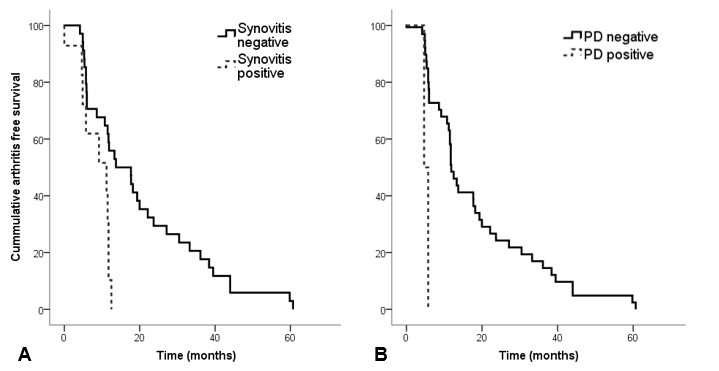Session Information
Session Type: ACR Poster Session A
Session Time: 9:00AM-11:00AM
Background/Purpose:
Early diagnosis of rheumatoid arthritis (RA) is important for controlling disease activity and preventing joint damage. Individuals positive for anticitrullinated protein antibodies (ACPA) and/or rheumatoid factor (RF) are at risk of developing RA. In this study we investigated whether ultrasound (US) can predict development of arthritis in seropositive arthralgia patients.
Methods:
We included ACPA and/or RF positive patients with arthralgia, but without clinical arthritis. US was performed at baseline in 12 joints: bilateral MCP2-3, PIP2-3, wrist and MTP5. Images were scored semiquantitatively for synovitis and Power Doppler (PD) on a scale of 0-3. Grades 2 to 3 for synovitis and grades 1 to 3 for PD were regarded as abnormal. The association of ultrasound abnormalities with the development of arthritis was analyzed using Fisher’s exact test, expressed as odds ratios (OR) with 95% confidence interval (CI). Kaplan Meier survival analysis with log-rank test and Cox regression analysis were used to assess the timing of arthritis development, expressed as median time to arthritis and hazard ratios (HR) with 95% CI.
Results:
In total, 169 seropositive arthralgia patients underwent US examination. Mean age was 51 (standard deviation (SD) 11) and 73% was female. Of these patients, 44 (22%) developed arthritis during a mean follow-up time of 27 (SD 19) months. Thirty seven (84%) patients developing arthritis satisfied the 2010 ACR/EULAR classification criteria for RA. Synovitis and PD signal in at least one joint was observed in 14 (8%) and 7 (4%) patients, respectively. The presence of synovitis was associated with arthritis development (OR 8.9, CI 2.6-30.2, p<.01, Table 1), whereas the presence of PD signal was not (OR 1.1, CI 0.2-6.1, p=1.0). Corresponding positive predictive values were 71% and 29%, respectively. Patients with synovitis or PD in at least one joint developed arthritis earlier than patients without US abnormalities (synovitis: median time to arthritis 11 versus 14 months, p<0.01; PD: median time to arthritis 5 versus 12 months, p<0.01; Fig 1) with corresponding HRs of 3.5 (CI 1.5-7.9, p<0.01) and 6.9 (CI 1.5-32.2, p<0.02) respectively.
Conclusion:
Synovitis on US predicted arthritis development in seropositive arthralgia patients. This association was not found for PD, however PD frequency was low and therefore the power to predict arthritis was low. However, when taking into account the time to arthritis development, both synovitis and PD were associated with an increased hazard on developing arthritis.

Figure 1. Kaplan-Meier survival curve for (A) synovitis and (B) Power Doppler (PD) and arthritis development
To cite this abstract in AMA style:
Blanken A, van Beers-Tas M, Meursinge Reynders M, van Schaardenburg D. Ultrasound Abnormalities Predict Arthritis Development in ACPA and/or RF Positive Arthralgia Patients [abstract]. Arthritis Rheumatol. 2017; 69 (suppl 10). https://acrabstracts.org/abstract/ultrasound-abnormalities-predict-arthritis-development-in-acpa-andor-rf-positive-arthralgia-patients/. Accessed .« Back to 2017 ACR/ARHP Annual Meeting
ACR Meeting Abstracts - https://acrabstracts.org/abstract/ultrasound-abnormalities-predict-arthritis-development-in-acpa-andor-rf-positive-arthralgia-patients/

